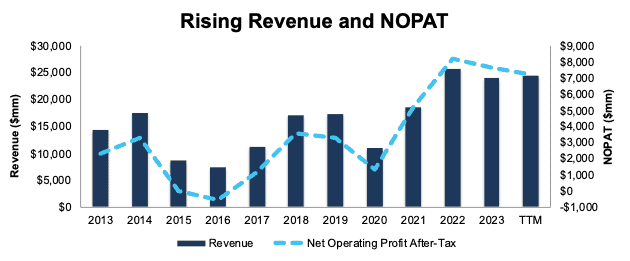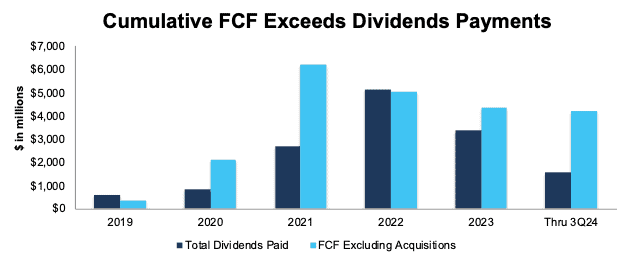The Fed is expected to cut rates one more time before the end of this year, but not all signals are bullish for the market. On the one hand, we have a new member of the one trillion-dollar market cap club as Broadcom (AVGO) soared on Friday after reporting fiscal fourth quarter. On the other hand, as of this writing, the market is on pace for its first weekly decline in four weeks. The brief pull back gives investors a chance to reevaluate their portfolio. Sitting on huge winners? Perhaps, now is a time to take some gains with many stocks sitting at record highs.
Looking for a haven in this volatile market that looks increasingly expensive? Dividends stocks could be the answer. As CEO David Trainer recently shared, quality stocks that pay dividends consistently is a great way for investors to protect themselves while boosting returns in a volatile market.
Today’s featured stock is from our Dividend Growth Model Portfolio, which consists of stocks that have the strong cash flow needed to support and growth their dividends. This free report is meant to give you a sense of the value our proven-superior research can add to your process. This featured stock summary is not a full Long Idea report, but it gives you insight into the rigor of our research and approach to picking stocks. We believe it’s important for you to see our research on stocks on a regular basis, whether or not you are a subscriber.
Our write-up is below. We hope you enjoy it. We hope you find value.
We update this Model Portfolio monthly. November’s Dividend Growth Model Portfolio was updated and published for clients on November 26, 2024.
Recap from October’s Picks
On a price return basis, our Dividend growth Model Portfolio (+6.4%) outperformed the S&P 500 (+2.7%) by 3.7% from October 30, 2024 through November 22, 2024. On a total return basis, the Model Portfolio (+6.5%) outperformed the S&P 500 (+2.7%) by 3.8% over the same time.
The best performing stock was up 20%. Overall, 17 out of the 25 Dividend Growth Stocks outperformed their benchmark (S&P 500) from October 30, 2024 through November 22, 2024.
This report leverages our cutting-edge Robo-Analyst technology to deliver proven-superior fundamental research and support more cost-effective fulfillment of the fiduciary duty of care.
Model Portfolio Methodology
This Model Portfolio mimics an “All Cap Blend” style with a focus on dividend growth. Selected stocks earn an Attractive or Very Attractive rating, generate positive free cash flow (FCF) and economic earnings, offer a current dividend yield >1%, and have a 5+ year track record of consecutive dividend growth. This Model Portfolio is designed for investors who favor long-term capital appreciation over current income, but still appreciate the power of growing dividends.
Featured Stock for November: Energy Company
This company has grown revenue and net operating profit after tax (NOPAT) by 5% and 11% compounded annually, respectively, over the past decade. The company’s NOPAT margin increased from 16% in 2013 to 30% in the TTM, while invested capital turns remained the same at 0.5. Rising NOPAT margins drive return on invested capital (ROIC) from 8% in 2013 to 15% in the TTM.
Figure 1: Revenue & NOPAT Since 2013
Sources: New Constructs, LLC and company filings
Free Cash Flow Supports Dividend Payments
This company has increased its regular, quarterly dividend from $0.22/share in 1Q19 to $0.98/share in 1Q25. The quarterly dividend, when annualized, equals $3.92/share and provides a 2.9% dividend yield.
More importantly, the company’s cumulative free cash flow (FCF) easily exceeds its dividend payments. From 2019 through 3Q24, the company generated $22.3 billion (29% of current enterprise value) in FCF while paying $14.2 billion in dividends, including special dividends. See Figure 2.
Figure 2: FCF vs. Dividends Since 2019
Sources: New Constructs, LLC and company filings
Companies with FCF well above dividend payments provide higher-quality dividend growth opportunities. On the other hand, dividends that exceed FCF cannot be trusted to grow or even be maintained.
This Stock Is Undervalued
At its current price of $127/share, this stock has a price-to-economic book value (PEBV) ratio of 0.7. This ratio means the market expects the company’s NOPAT to permanently fall 30% from current levels. This expectation seems overly pessimistic given that the company has grown NOPAT by 13% and 11% over the past five and ten years, respectively.
Even if the company’s NOPAT margin falls to 22% (below five-year average of 25% and TTM margin of 30%) and revenue grows just 3% (compared to 5% compounded annually over the last decade) compounded annually for the next decade, the stock would be worth $164/share today – a 29% upside. In this scenario, the company’s NOPAT would fall 1% compounded annually through 2033.
Add in the company’s 2.9% dividend yield and a history of dividend growth, and it’s clear why this stock is in November’s Dividend Growth Stocks Model Portfolio.
Critical Details Found in Financial Filings by Our Robo-Analyst Technology
Below are specifics on the adjustments we make based on Robo-Analyst findings in this featured stock’s 10-K and 10-Q:
Income Statement: we made over $700 million in adjustments with a net effect of removing over $60 million in non-operating expense. Clients can see all adjustments made to the company’s income statement on the GAAP Reconciliation tab on the Ratings page on our website.
Balance Sheet: we made just over $20 billion in adjustments to calculate invested capital with a net increase of over $7 billion. The most notable adjustment was for asset write downs. See all adjustments made to the company’s balance sheet on the GAAP Reconciliation tab on the Ratings page on our website.
Valuation: we made over $16 billion in adjustments, with a net effect of decreasing shareholder value by over $5 billion. The most notable adjustment to shareholder value was for deferred tax liabilities. See all adjustments to the company’s valuation on the GAAP Reconciliation tab on the Ratings page on our website.
…there’s much more in the full report. You can start your membership here to get access to this report and much more.


